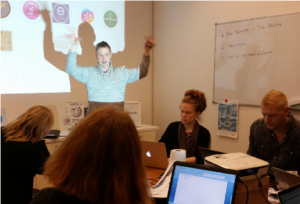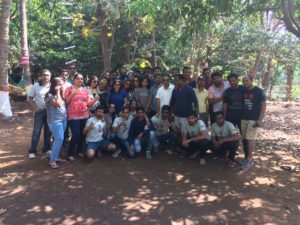All teams can benefit from team building activities, no matter their size and experience. Team building activities usually work on four main aspects- communication, problem solving/ decision making, adaptability and trust. These activities are organized both inside the office, in the form of group games and sessions, and outside, through corporate retreats and adventures.
Here are the best options for team building activities in office-
Group Timeline

What is it?
On a bulletin board, create a timeline dating back to the birth date of the oldest member of the team. Then, on post-its or pieces of paper, write down significant dates for the company- like inception, website launch, etc and put this up on the timeline. Ask each team member to take 5 pieces of paper and write 5 of the most significant events in their life. Stack all of these up on the timeline as well.
How does it help?
This exercise helps represent the experiences of all members and the company, visually. Often generation gaps can make communication difficult since younger employees cannot relate to the experiences of their seniors and vice-versa. This helps employees from different generations get to know each other and bond more.
Help me walk
What is it?
The participants are divided into groups of two. Place simple obstacles around the office. This could be as simple as moving desks around and rearranging chairs. One partner from each team is blindfolded. The other partner has to help them navigate around a whole predefined path, by only talking to them. Try and incorporate flights of stairs in the path. Then the roles can be switched and the other partner gets blindfolded while the first one gives him instructions.
How does it help?
This activity is, at face value, an effective trust-building exercise. But it also helps participants improve their listening skills, a key to learning more and learning better. Also, by teaming up members who don’t interact much with each other, it helps learn about how they communicate.
What’s on your desk?
What is it?
Each member brings one item from their desk. Divide the team into groups of 3-4. Each team has to first choose one object from the objects they’ve brought. And then create a sales pitch around that object. They then present this pitch to the other members. At the end of each pitch, the audience gives their inputs on what they liked and what could be improved about the pitch.
How does it help?
This develops the problem solving and decision-making skills of the team as a whole. First, the members need to decide which object to choose, what could sell the most. And then create a pitch around it. The discussions at the end encourage the entire team to put their heads together and think strategically.
Show and Tell

What is it?
This is an activity organized for children in school. But it’s a simple, effective way activity for any team. Each person brings an item that represents what they’re currently working on- it could be a photo, an app being developed on their phone, a new product they’re about to launch, etc. They show the object they’ve got, explain why they brought it, what they love about it and what efforts have gone into it.
How does it help?
We love to share our work and achievements with our team. But often, people tend to bury themselves in their own work. They don’t share thoughts and ideas as much. This activity helps teammates connect, and gives everyone a holistic viewpoint on what’s going on with the team. It improves communication, and often, when you discuss your current project with other teammates, having them discuss it can give you a fresh perspective on it.
Role Switch
What is it?
This is an effective choice if you have an entire day or at least half a day. Write down the names of all team members in chits. Each member draws a chit. They then have to take on that person’s work responsibilities for the entire day. Make sure all members have a small, easy to understand task list decided beforehand, so the person who takes on their role does not spend too much time collecting background information. Also, try and ensure the exchanges are within the same field. For eg, a marketing officer may not be able to take on the role of a developed, and vice-versa.
How does it help?
This is a way to plan an entire fun day of team activity. It helps people know each other’s roles better. There will also be a lot of back and forth communication as team members try to get the hang of a completely different role. It helps employees appreciate the skills that others bring to the table.

Team building activities in office take up very few resources, are a fun break from routine and effective in improving communication and trust.
Often, a great option is to plan a fun day or weekend out, and take your team on an adventure retreat. Sometimes, being in the midst of nature can help drive home important learnings, that being in an office space cannot. Whatever your training objectives are, we can help you achieve them with Outbound training programs and team building programs that are best suited for your team.
Looking for more? Here are some other articles to help boost your team’s performance:




